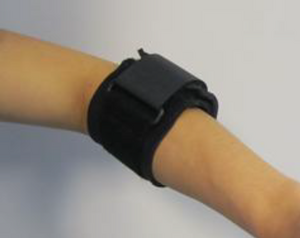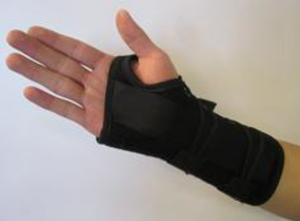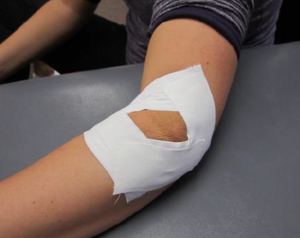Lateral Epicondyle Tendinopathy Toolkit: Section H - Braces, Splints, and Taping: Difference between revisions
No edit summary |
No edit summary |
||
| Line 21: | Line 21: | ||
== Introduction == | == Introduction == | ||
Various methods have been developed to treat lateral epicondyle tendinopathy that includes brace, [[Splinting|splints]] and [[taping]] | Various methods have been developed to treat lateral epicondyle tendinopathy that includes brace, [[Splinting|splints]] and [[taping]]. | ||
== Counterforce Brace | Splinting, bracing and taping are used to protect, support, or immobilise an injured or inflamed areas. These interventions have been found to be effective. | ||
A counterforce brace is one of the most conventional treatments. | |||
== Counterforce Brace == | |||
A counterforce brace is one of the most conventional treatments. A combined cadaveric and clinical study<ref>Meyer NJ, Walter F, Haines B, Orton D, Daley RA. [https://pubmed.ncbi.nlm.nih.gov/12671861/ Modeled evidence of force reduction at the extensor carpi radialis brevis origin with the forearm support band.] The Journal of hand surgery. 2003 Mar 1;28(2):279-87.</ref> showed a 13-15% force reduction of the [[External carpi radialis brevis|ECRB]] origin with the counterforce brace. | |||
* They are often used for pain relief. | |||
* They are thought to diffuse the load through the tendon to less sensitive areas, thereby decreasing the stress on the area of pathology. | |||
[[File:LET Appendix E Fig1.png|thumb|Counterforce Badge]] | [[File:LET Appendix E Fig1.png|thumb|Counterforce Badge]] | ||
| Line 34: | Line 39: | ||
== Wrist Splint == | == Wrist Splint == | ||
* Wrist splints are less commonly used in the LET. | |||
* But they do have some support for temporary pain relief in more acute patients. | |||
* The goal is to rest the musculotendinous unit originating at the lateral epicondyle. | |||
[[File:LET Appendix E Fig2.png|thumb|Wrist splint]] | [[File:LET Appendix E Fig2.png|thumb|Wrist splint]] | ||
<br> | <br> | ||
| Line 43: | Line 51: | ||
== Diamond Taping Technique == | == Diamond Taping Technique == | ||
Diamond Taping Technique <ref>Vicenzino B, Brooksbank J, Minto J, Offord S, Paungmali A. Initial effects of elbow taping on pain-free grip strength and pressure pain threshold. Journal of Orthopaedic & Sports Physical Therapy. Jul 2003; 33(7): 400-7.</ref>consists of four tape strips, repeated twice. The tape is laid in a diamond shape while pulling the soft tissues centrally towards the lateral epicondyle | |||
* The goal is to decrease tension at the epicondyle attachment. | |||
* Diamond Taping Technique <ref>Vicenzino B, Brooksbank J, Minto J, Offord S, Paungmali A. Initial effects of elbow taping on pain-free grip strength and pressure pain threshold. Journal of Orthopaedic & Sports Physical Therapy. Jul 2003; 33(7): 400-7.</ref>consists of four tape strips, repeated twice. | |||
* The tape is laid in a diamond shape while pulling the soft tissues centrally towards the lateral epicondyle. | |||
[[File:LET Appendix E Fig3.png|thumb|Diamond taping technique]] | [[File:LET Appendix E Fig3.png|thumb|Diamond taping technique]] | ||
<br> | <br> | ||
Revision as of 12:46, 14 October 2022
This article is currently under review and may not be up to date. Please come back soon to see the finished work! (14/10/2022)
Toolkit Navigation
- Introduction and Background
- Summary of the Evidence
- Treatment Algorithm
- Appendix A: Details of the Articles
- Appendix B: Manual Therapy
- Appendix C: Details of Exercise Prescription
- Appendix D: LASER Dosage Calculation
- Appendix E: Braces, Splints, and Taping
- Appendix F: Outcome Measures
- Appendix G: Medical and Surgical Interventions
Introduction[edit | edit source]
Various methods have been developed to treat lateral epicondyle tendinopathy that includes brace, splints and taping.
Splinting, bracing and taping are used to protect, support, or immobilise an injured or inflamed areas. These interventions have been found to be effective.
Counterforce Brace[edit | edit source]
A counterforce brace is one of the most conventional treatments. A combined cadaveric and clinical study[1] showed a 13-15% force reduction of the ECRB origin with the counterforce brace.
- They are often used for pain relief.
- They are thought to diffuse the load through the tendon to less sensitive areas, thereby decreasing the stress on the area of pathology.
Wrist Splint[edit | edit source]
- Wrist splints are less commonly used in the LET.
- But they do have some support for temporary pain relief in more acute patients.
- The goal is to rest the musculotendinous unit originating at the lateral epicondyle.
Diamond Taping Technique[edit | edit source]
- The goal is to decrease tension at the epicondyle attachment.
- Diamond Taping Technique [2]consists of four tape strips, repeated twice.
- The tape is laid in a diamond shape while pulling the soft tissues centrally towards the lateral epicondyle.
Resources[edit | edit source]
Lateral Epicondyle Tendinopathy (LET) Toolkit
Download Lateral Epicondyle Tendinopathy Toolkit: Appendix E - Braces, Splints, and Taping
Acknowledgements[edit | edit source]
Developed by the BC Physical Therapy Tendinopathy Task Force: Dr. Joseph Anthony, Dr. Angela Fearon, Diana Hughes, Carol Kennedy, Dr. Alex Scott, Michael Yates, & Alison Hoens.
A Physical Therapy Knowledge Broker project supported by: UBC Department of Physical Therapy, Physiotherapy Association of BC, Vancouver Coastal Research Institute and Providence Healthcare Research Institute.
June 2013
References[edit | edit source]
- ↑ Meyer NJ, Walter F, Haines B, Orton D, Daley RA. Modeled evidence of force reduction at the extensor carpi radialis brevis origin with the forearm support band. The Journal of hand surgery. 2003 Mar 1;28(2):279-87.
- ↑ Vicenzino B, Brooksbank J, Minto J, Offord S, Paungmali A. Initial effects of elbow taping on pain-free grip strength and pressure pain threshold. Journal of Orthopaedic & Sports Physical Therapy. Jul 2003; 33(7): 400-7.









